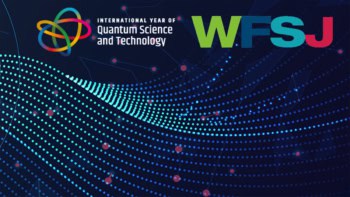Recent TV programmes have claimed that the Earth could be destroyed by black holes created in particle accelerators and that helium-3 from the Moon could be used for fusion energy. Frank Close warns that these “factoids” must be stamped out before they become accepted as facts

Did you know that when the Large Hadron Collider (LHC) comes online at CERN next spring, it could end up creating mini black holes that destroy the Earth? This is not something from a Dan Brown novel, but from a TV documentary broadcast as part of the BBC’s Horizon series in the UK on 1 May – a programme that has been running for 40 years and is supposedly the flagship of TV science in the country. Although the documentary itself was fairly measured, the producers began the programme with the black-hole claim and used it in their publicity for the show.
Physicists who recall superb Horizon documentaries of the past – for example, on the discovery of the W and Z bosons – will have been disappointed that such a marvellous project as the LHC should have been sensationalized in this way. It was disheartening that the programme makers felt the need to rehash these unnecessary concerns over black holes being produced in particle accelerators, which physicists had already dismissed before the Relativistic Heavy Ion Collider (RHIC) came online at the Brookhaven National Laboratory in 2000 (Physics World July 2000 pp19–20, print edition only).
Meanwhile, another Horizon documentary, broadcast on 10 April, claimed that one reason for sending humans to the Moon is so that we can mine it for helium-3 as a fuel for fusion power back on Earth. The need to bring helium-3 back from the Moon has even been briefly referred to in Physics World (May 2007 pp12–13, print edition only) and, more worryingly, has been presented to US congressional committees, including the Science and Technology Committee of the House of Representatives in 2004.
As a particle physicist, I am of course interested in the LHC; and as the chair of a working group set up by the British National Space Centre to look into the future of UK space science – including the possibility of humans returning to the Moon – I am also intrigued by the helium-3 story. Both of the claims bother me and, on investigation, each is revealed as an example of what I call “factoid science” – myths of dubious provenance that propagate, become received wisdom and could even influence policy. So what is the reality and what can physicists do to correct such mis-information?
Strangelet statistics
The story of the LHC as an Armageddon machine would be laughable were it not so serious. Aficionados of Dan Brown – whose novel Angels and Demons was set partly at CERN – might believe that the Geneva lab produces antimatter capable of making weapons of mass destruction. But I did not expect to find similarly outlandish statements used to promote Horizon. As the programme’s website puts it: “Some scientists argue that during a 10-year spell of operation there is a 1 in 50 million chance that experiments like the LHC could cause a catastrophe of epic proportions.” The site then invites the public to take part in a poll on whether the LHC should be turned on or not, based on this “probability”.
While the LHC will create the most energetic collisions ever seen on Earth, cosmic rays at these and even higher energies have been bombarding our and other planets for billions of years without mishap. When I asked the producers of Horizon where they had obtained the 1-in-50-million statistic, I was told it had been taken from a “reliable source”: Our Final Century by Cambridge University cosmologist Martin Rees. But when I read his book, it became clear that the programme’s research had sadly been incomplete. On page 124, Rees discusses a paper published in 1999 by CERN theorists Arnon Dar, Alvaro de Rújula and Ulrich Heinz that uses the fact that the Earth and the cosmos have survived for several billion years to estimate the probability of colliders producing hypothetical particles called “strangelets” that might destroy our planet (1999 Phys. Lett. B 470 142).
Rees fairly describes their conclusions as follows: “If the experiment were run for 10 years, the risk of catastrophe was no more than 1 in 50 million.” In other words, the chance of disaster is one in at least 50 million (as no disaster has occurred); this is rather different from saying, as Horizon does, that there is a “1 in 50 million” probability of a catastrophe happening from the moment the LHC switches on.
Moreover, when Dar and colleagues wrote their 1999 paper, a committee of eminent physicists appointed by the Brookhaven lab was also investigating if RHIC could produce strangelets (arXiv:hep-ph/ 9910333v3). That study used not just information from cosmology but also data from collisions between heavy ions (albeit at lower energies than RHIC would obtain) to show that the chances of catastrophe are at least one part in 1019.
Furthermore, these figures refer specifically to strangelets being produced at RHIC, as Rees makes clear, and have nothing to do with the question of whether we should risk creating black holes. Indeed, why does Horizon talk about black holes at all? The only reason can be that a theory does exist that posits that mini black holes could be produced in a collider. But if one mentions this theory, then one must include the whole of it, which clearly states that mini black holes pose no hazard whatsoever because they do not grow but evaporate and die.
As if any more evidence was needed that colliders are safe, CERN also set up an “LHC safety-study group” to see if its new collider could create black holes or strangelets. It concluded – in an official CERN report published in 2003 (CERN-2003-001) – that there is “no basis for any conceivable threat” of either eventuality, which is as near as science can get to saying zero. Unfortunately, the Horizon programme made no mention of these serious and time-consuming enquiries even though CERN’s press office gave the programme’s researchers a copy of the lab’s 2003 report. Instead, the public has been led to believe that scientists are prepared to embark on experiments that could spell the end of the planet.
Helium errors
Let me now turn to the helium-3 factoid. At most fusion experiments, such as the Joint European Torus (JET) in the UK, a fuel of deuterium and tritium nuclei is converted in a tokomak into helium-4 and a neutron, thereby releasing energy in the process. No helium-3 is involved, so where does the myth come from? Enter “helium-3 fusion” into Google and you will find numerous websites pointing out that the neutron produced in deuterium–tritium fusion makes the walls of the tokomak radioactive, but that fusion could be “clean” if only we reacted deuterium with helium-3 to produce helium-4 and a proton.
Given that the amount of helium-3 available on Earth is trifling, it has been proposed that we should go to the Moon to mine the isotope, which is produced in the Sun and might be blown onto the lunar surface via the solar wind. Apart from not even knowing for certain if there is any helium-3 on the Moon, there are two main problems with this idea – one obvious and one intriguingly subtle. The first problem is that, in a tokomak, deuterium reacts up to 100 times more slowly with helium-3 than it does with tritium. This is because fusion has to overcome the electrical repulsion between the protons in the fuel, which is much higher for deuterium– helium-3 reactions (the nuclei have one and two protons, respectively) than it is for deuterium– tritium reactions (one proton each).
Clearly, deuterium–helium-3 is a poor fusion process, but the irony is much greater as I shall now reveal. A tokomak is not like a particle accelerator where counter-rotating beams of deuterium and helium-3 collide and fuse. Instead, all of the nuclei in the fuel mingle together, which means that two deuterium nuclei can rapidly fuse to give a tritium nucleus and proton. The tritium can now fuse with the deuterium – again much faster than the deuterium can with helium-3 – to yield helium-4 and a neutron.
So by bringing helium-3 from the Moon, all we will end up doing is create a deuterium– tritium fusion machine, which is the very thing the helium aficionados wanted to avoid! Undeterred, some of these people even suggest that two helium-3 nuclei could be made to fuse with each other to produce deuterium, an alpha particle and energy. Unfortunately, this reaction occurs even more slowly than deuterium–tritium fusion and the fuel would have to be heated to impractically high temperatures that would be beyond the reach of a tokomak. And as not even the upcoming International Thermonuclear Experimental Reactor (ITER) will be able to generate electricity from the latter reaction, the lunar-helium-3 story – like the LHC as an Armageddon machine – is, to my mind, moonshine.
Rising pressure
Does any of this matter beyond raising the blood pressure of some physicists? All publicity is good publicity, some might say. But I believe we should all be concerned. The LHC factoid has now been repeated in the New Yorker and in various reviews of the Horizon documentary. Even some nonphysics colleagues are asking me to explain what it is all about. If Horizon claims to be the flagship TV science series on which the public rely to form their opinions, I would hope that their researchers do their research, and that the editors then take due account of it.
The factoids about mining the Moon for fusion fuel and of the LHC Armageddon make a cautionary tale. A decade from now it is possible that committees of well-informed scientists and rather less-well-informed politicians, with public opinion weighing on their minds, will be deciding on our involvement in mega-projects such as the next huge accelerator, human space exploration, or even a post-ITER commercial fusion plant.
Decision making driven by public opinion that is influenced by factoids already has a dire history in the bio-medical arena: the controversy over whether to give children a combined immunization against measles, mumps and rubella (MMR) being the most recent example. My advice is that if you see an error in the media, speak out, write to the editors and try to get corrections made. It is an opportunity to get good science in the news.



